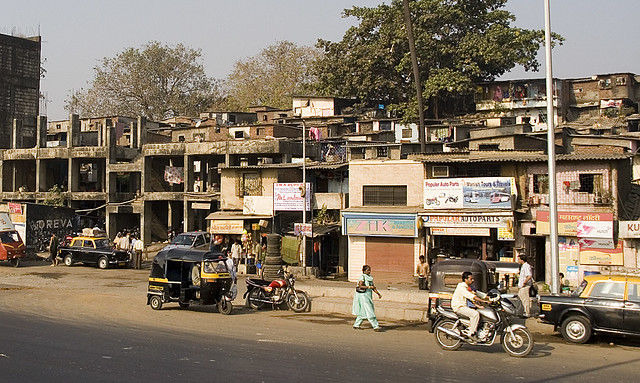[ Rameshwari Takle is an Indian native who came to the US to study architecture at IIT. She was kind enough to write this piece for us about Mumbai, Indian, where she previously lived – Aaron. ]

Photo Credit: Flickr/Dey
Mumbai is the largest city in India, a city full of dreamers and hard-laborers. A place where you will encounter stray dogs and exotic birds, artists and workers, the poor and millionaires living together in this maddening city. The city is the home of the most prolific of film industries (Bollywood), one of Asia’s biggest slums (Dharavi), and the largest tropical forest in an urban zone.
In many ways, I see a lot of similarity between New York and Mumbai, with their roles in the United States and India respectively. Mumbai is India’s financial capital, fashion powerhouse, and a center for many religious and political matters. It has some of the world’s most expensive real estate with property rates soaring sky high, some of them up to 100,000 INR/SF. A rapid growth and development has made the city a concoction of skyscrapers and malls in between the slums and shabby areas. It is also one of the most populous cities in the world with a population of 21,290,000 as of January 2012.
In the urban context, Mumbai has portrayed a very ironic image of itself. The most common image of the city and the one the world knows about is the slums. But, at the same time, the luxury developments and tall buildings due to rapid urbanization has given rise to a lot of speculation and debate about the urban sustainability and economic equality both in local and global discussions.
In terms of employment, 81% of the city’s population works in the services sector, including communications, social, and personal services. In Mexico City the service sector is around 43% and in Shanghai is around the 32%. Johannesburg, New York and Berlin see 37%, 46% and 40% employed in services, respectively. Most famous among the services produced in Mumbai is cinema. Bollywood churns out more than 900 films a year — more than any other film center (yes, Hollywood included), with many people directly and indirectly employed by this industry. Although every part of the country has its regional film industry, Bollywood continues to enthrall the nation with its winning escapist formula of complete entertainment with typical song and dance sequences (widely popular among foreign audience). Cinema in India is a phenomenon, the form of media that has the ability to create the greatest impact on the masses. Bollywood stars can attain near godlike status in India. Their faces appear in advertisements around the country. According to me there are only two things most popular in India, especially Mumbai — Bollywood and Cricket.
Mumbai is very well known for its fast paced lifestyle and the citizens of Mumbai are believed to be the most active in the entire country. Most of the cities in India are laidback in terms of the lifestyle and people, but Mumbai is completely opposite of that. People in this city are very hard working. They also have to travel long distances to reach their work. Almost 80% of the citizens rely on the Mumbai local train system, which is the lifeline of the city. Everything in Mumbai carries a high price tag, which may be why everyone works so hard. Residents often take up extra part time jobs to earn more money. People from other parts of India come here to earn their living and make money. This makes Mumbai a cosmopolitan center, with many ethnic groups among which Maharastrians form the majority.
Street food and vendors are a common sight in Mumbai especially in the working district of the city. Mumbai is well known for its local food joints and street food is very popular amongst the citizens. Other cultural staples include Indian festivals like the Ganesh Chaturthi, Diwali, and Holi are celebrated in Mumbai. These festivals are celebrated in grandeur and unite all the citizens of Mumbai irrespective of caste and creed.
The globally popular film Slumdog Millionaire showed the world the city’s slums. 60% of Mumbai’s population lives in its shantytowns and slums. Contrary to what is shown in the movie, life in the slums is pretty normal. The residents of the slums pay rent. The building materials for these houses might range from flimsy corrugated-iron shacks to permanent, multi-storey concrete structures. But most houses have kitchens and electricity. The children there go to schools – most of them to the municipal schools with affordable fees as compared to the private schools. Many families have been here for generations, and some of the younger Dharavi residents even work in white-collar jobs. Dharavi has Asia’s largest leather tanning industry. Based on my personal interaction with the slum dwellers during a school project, I realized that the residents of these slums often choose to stay in the neighborhood they grew up in. Whether it is because of the fear of discrimination or the fear to accept change, they are certainly more comfortable living where they are and the surroundings they are familiar with.
I believe one should take the time to get to know Mumbai and appreciate the city for what it has to offer. The luxury lifestyle of south Mumbai and the slums, the crazy traffic and the local trains, the street vendors and the high end restaurants, the humid climate and the cool breeze of the Marine Drive, the historic architecture and the market places, the movies and the cricket, the urban and local character. The city will suck you in if you let it.